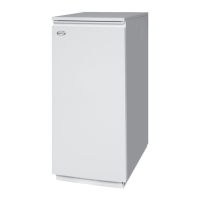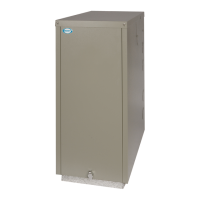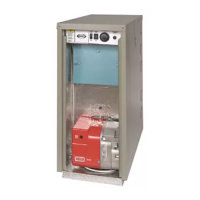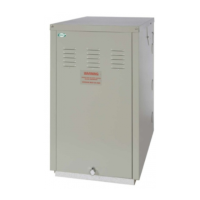30
10 Commissioning
PRO EXTERNAL
BOILER ON/OFF SWITCH
ISOLATES PUMP(IF WIRED
INTO BOILER CONTROL
PANEL) & BURNER ONLY.
THIS COVER ISTO BE
REMOVED BYQUALIFIED
PERSONNELONLY
DO NOTREMOVE COVER
WITHOUTISOLATING
SWITCHED LIVEAND
FROST'STAT
PERMANENTLIVE
TESTSWITCH
OVERIDES SYSTEM
CONTROLSTO
OPERATE BOILER
‘Lock-out’ reset button
Boiler front
panel removed
Control Panel
DANGER
THERE IS MORE THAN ONE LIVE SUPPLY TO
THIS CONTROL PANEL
BOILER
OFF
OVERHEAT
RESET
TEST
SWITCH
OFF
HEATING
THERMOSTAT
ON ON
REFER TO WIRING DIAGRAM IN MANUAL
Overheat thermostat
reset button
(under screw cover)
Boiler
thermostat
Boiler
On/Off switch
Test
switch
DANGER
THERE IS MORE THAN ONE LIVE SUPPLY TO
THIS CONTROL PANEL
BOILER
OFF
OVERHEAT
RESET
TEST
SWITCH
OFF
HEATING
THERMOSTAT
ON ON
REFER TO WIRING DIGRAM IN MANUAL
Figure 10-1: Boiler controls
It is important that the following
commissioning procedure is carried out
to ensure safe and efficient operation of
the boiler.
To access the controls, remove the front
panel (turn the handle and withdraw it
forwards at the bottom).
The controls are shown in Figure 10-1.
10.1 Before Switching On
1. Ensure the boiler On/Off switch and
the test switch are set to OFF.
2. Check that the high limit thermostat
and boiler thermostat bulbs are
correctly located in their respective
pockets. Refer to Figure 5-1.
Check condition of thermostat
capillaries, not damaged, broken or
kinked and not crushed.
3. Remove the nuts and washers
securing the front cleaning door.
Withdraw the door - take care it is
HEAVY!
4. Check that the turbulators are in
position and that the ends are
vertical.
5. Check that the baffles are in
position. Refer to Figures 11-1 or
11-2 as required.
6. Re-fit the cleaning door and check
it is fitted correctly and that a good
seal is made.
7. Remove and check the burner.
Check that the burner head is
correct.
Refer to Section 2.3.
Check the electrodes are set correctly.
Refer to Figure 11-6.
Check the nozzle is correct for the
output rating required. Refer to Section
2.3.
8. Check that the water system has
been vented (and pressurised if
sealed system) and there are no
leaks.
9. Ensure the automatic air vent on
the condensing heat exchanger is
open.
10. Check that all fuel line valves are
open.
11. Remove the plastic burner cover if
it was not previously removed.
12. Connect a combined vent manifold
and pressure gauge to the
pressure gauge connection port on
the oil pump. See Figure 3-6. Open
the vent screw on the vent manifold
to vent the supply while the pump
is running.
13. Check that all system controls are
calling for heat and turn the boiler
thermostat to maximum.
10.2 Switching On
1. Switch on the electricity supply.
2. Set the Boiler On/Off switch to ON.
A neon in the switch lights when it
is in the ON position.
The boiler will now light
automatically.
Note that the neon lights when the
boiler is switched on, but does not
necessarily indicate the burner is
firing.
3. The burner fan should start and the
burner should light within about 12
seconds.
If the burner does not light and
the ‘Lock-out’ reset button lights,
wait for about 45 seconds then
press the reset button to restart the
ignition process.
This procedure may have to be
repeated several times during first
lighting.
4. With the burner alight, check the
fuel pressure.
5. Refer to the Technical Information,
Section 2.3.
6. Adjust the pressure if necessary -
see Figure 3-6.
7. Operate the boiler until it reaches
normal operating temperature.
Check oil supply/return pipe for
leaks, rectifying where necessary.
If a 15/21 model is down rated, the
burner air adjuster disc must be
adjusted to setting B as described
in Section 10.6. Refer also to
Section 2.3.
If a 21/26 or 26/35 model is down
rated, the burner head must be
changed to a T1 head. See Section
11.4. Refer also to Section 2.3.
!
NOTE
It is important that the oil pressure
is correctly set.
!
NOTE
